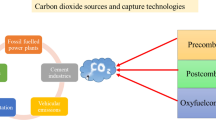Abstract
Currently, the applications of nanomaterials have been sparsely addressed regarding adsorption and the separation of gases. Concerning their applications in the field of gas adsorption, high specific surface area and stability in the chemical reaction are important concerns for nanomaterials. This paper focuses on the system hybridization of activated carbon and carbon nanofibers (CNF) produced from coconut shells, which is used for ammonia adsorption process. The purpose of this research is to fabricate activated carbon and CNF based on coconut shell, and then apply them for the adsorption of ammonia to eliminate its odor. After that, this study analyzed the adsorption speed rate from the inlet system. Ammonia adsorption in this work was conducted using the batch adsorption method and measured using the adsorption speed rate supported by the TGS826 sensor. Activated carbon and CNT were also characterized in terms of their surface morphological tests using scanning electronic microscopy (SEM) and Fourier transform infra-red (FTIR) to determine the particle size, morphological form, and the functional groups of material. The results indicated that activated carbon has a better performance compared to CNF regarding its ammonia adsorption capability due to the SEM and FTIR result test. Moreover, particle size has an impact on the adsorption process.







Similar content being viewed by others
References
O. Gómez-Cápiro, A. Hinkle, A.M. Delgado, C. Fernández, R. Jiménez, L.E. Arteaga-Pérez, Catalysts 8(9), 347 (2018)
T.J. Wang, I.H. Im, Proc. Inst. Mech. Eng. Part D J. Automob. Eng. 1–13 (2019)
H.T. Vo, J. Kim, N.Y. Kim, J.K. Lee, J.B. Joo, J. Ind. Eng. Chem. 91, 129–138 (2020)
Y.L. Zhao, W.J. Yang, J.H. Zhou, Z.H. Wang, J.Z. Liu, K.F. Cen, Ranliao Huaxue Xuebao/J. Fuel Chem. Technol. 43(12), 1470–1475 (2015)
N. Li, X. He, L. Chen, Y. Zhang, Chem. Asian J. 4(2), 286–293 (2009)
J. Smeraldi, G. Rajagopalan, W.J. Cooper, T. Hosseini, D. Rosso, in Nanotechnol. 2010 Bio Sensors, Instruments, Medical, Environment and Energy: Technical Proceedings of the 2010 NSTI Nanotechnology Conference and Expo, NSTI-Nanotech 2010, pp. 893–898 (2010)
S. Moosavi, C.W. Lai, S. Gan, G. Zamiri, O. Akbarzadeh Pivehzhani, M.R. Johan, ACS Omega 5(33), 20684–20697 (2020)
A.G. Bannov, O. Jašek, J. Prášek, J. Buršík, L. Zajíčková, J. Sens. 2018, 1–14 (2018)
S.J. Park, J.S. Shin, J. Metastab. Nanocrystalline Mater. 7–10 (2005)
X. Duan, J. Zhou, G. Qian, P. Li, X. Zhou, D. Chen, Cuihua Xuebao/Chin. J. Catal. 36(12), 2049 (2010)
J. Ji, X. Duan, G. Qian, P. Li, X. Zhou, D. Chen, W. Yuan, Catal. Today 254–260 (2013)
V. Adavan Kiliyankil, B. Fugetsu, I. Sakata, Z. Wang, M. Endo, J. Colloid Interface Sci. 582, 950–960 (2021)
N. Hiremath, G. Bhat, in Structure and Properties of High-Performance Fibers 79–109 (2017)
J. Huang, Pure Appl. Chem. 78(1), 15–27 (2006)
W.M.A.W. Daud, W.S.W. Ali, Bioresour. Technol. 93(1), 63–69 (2004)
A. Melati, E. Hidayati, J. Phys. Conf. Ser. 694 012073, 1–6 (2016)
P. Kalinowski, L. Wozniak, G. Jasinski, P. Jasinski, Time Window based Features Extraction from Temperature Modulated Gas Sensors for Prediction of Ammonia Concentration, in EMPC 2017—21st Eur. Microelectron. Packag. Conf. Exhib., vol 2018 (2018), pp. 1–5
I. Harmanli, N.V. Tarakina, M. Antonietti, M. Oschatz, J. Am. Chem. Soc. 143, 9377–9384 (2021)
B. Jafari, M.R. Rahimi, M. Ghaedi, K. Dashtian, S. Mosleh, Chem. Eng. Res. Des. 129, 64–74 (2018)
A. Palliyarayil, P.S. Prakash, S. Nandakumar, N.S. Kumar, S. Sil, Diam. Relat. Mater. 107, 107884 (2020)
T.J. Bandosz, C. Petit, J. Colloid Interface Sci. 338(2), 329–345 (2009)
T. Siengchum, M. Isenberg, S.S.C. Chuang, Fuel 105, 559 (2013)
D. Wibowo. Maulidiyah, R. Salamba. Hikmawati, M. Nurdin, Orient. J. Chem. 31, 2337 (2015)
Figaro Engineering Inc, TGS 826 Data Sheet. Prod. Inf., 1–3 (2004)
Acknowledgements
We sincerely thank Professor Kuwat Triyana from the Faculty of Mathematics and Natural Sciences of Gadjah Mada University for the generous support of smart discussion around the TGS sensor application and the laboratory team of Nanotechnology of UIN Sunan Kalijaga, Yogyakarta, Indonesia.
Author information
Authors and Affiliations
Contributions
Conceptualization, methodology, formal analysis and investigation were performed by Asih Melati and Galih Padmasari. Asih Melati was responsible for writing—original draft preparation. Galih Padmasari, Rama Oktavian and Frida Agung Rakhmadi were involved in writing—review and editing.
Corresponding author
Ethics declarations
Conflict of interest
The authors declare that they have no conflict of interest.
Ethical approval
This manuscript does not contain any studies with human participants or animals performed by any of the authors.
Additional information
Publisher's Note
Springer Nature remains neutral with regard to jurisdictional claims in published maps and institutional affiliations.
Rights and permissions
About this article
Cite this article
Melati, A., Padmasari, G., Oktavian, R. et al. A comparative study of carbon nanofiber (CNF) and activated carbon based on coconut shell for ammonia (NH3) adsorption performance. Appl. Phys. A 128, 211 (2022). https://doi.org/10.1007/s00339-022-05336-z
Received:
Accepted:
Published:
DOI: https://doi.org/10.1007/s00339-022-05336-z




